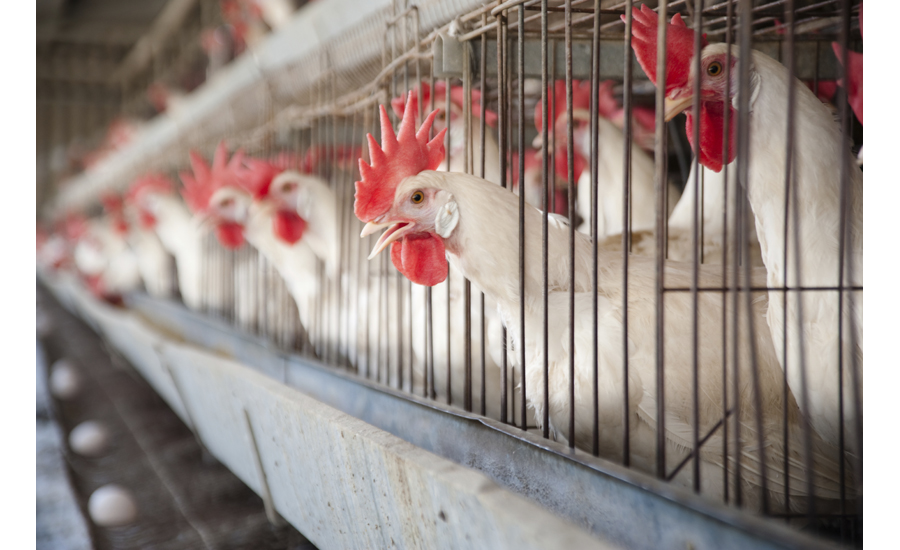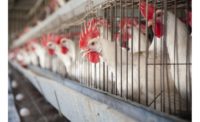Since December 2014, USDA’s Animal and Plant Health Inspection Service (APHIS) has confirmed several cases of highly pathogenic avian influenza (HPAI) H5 in U.S. migratory bird paths. By April 20, the first major reports related to infection of commercial egg-laying poultry started coming in, with 3.8 million chickens impacted on an Iowa farm reported on that date, per USDA.
Spread of HPAI H5 has continued, significantly impacting the U.S. egg market. USDA is currently reporting HPAI H5 detection in 20 U.S. states—15 states with outbreaks in domestic poultry or captive birds and five states with detections in wild birds only.
Egg producers across Nebraska, North Dakota, Minnesota, Wisconsin, Iowa and Wisconsin—collectively known as the current avian influenza “hot zone”—have been severely impacted, with HPAI H5 resulting in the deaths of an estimated 35 million egg-laying hens, a loss of about 12 percent of the domestic egg industry. (For more on the details on egg replacement tactics and solutions, see “Egg replacements to the rescue.”)
Centers for Disease Control and Prevention (CDC) has reported that it considers the risk to people from HPAI H5 infections in wild birds, backyard flocks and commercial poultry, to be low. No human infections with the virus have been detected to date.
Open-ended questions
The length of the impact of the current HPAI outbreak is unknown. This is due to the fact that the vector by which the HPAI H5 infections continue to spread has yet to be determined.
The most-recent report from USDA, on June 3, notes that personnel continue to work with state and local partners and poultry producers impacted by HPAI H5. USDA also continues to evaluate the efficacy of current vaccine options, concluding that additional criteria must still be met before a vaccine can be approved for emergency use. USDA also continues to support efforts to reach out to trading partners to avoid significant market disruptions.
While the egg industry overall will see impact from this outbreak, an immediate concern is shortages of egg products used in food manufacturing—particularly in the bakery industry.
Pasteurized egg product supplies are dwindling—a situation that has, and will to, cause price spikes. “The situation here, especially when it comes to pricing, is really a matter of economics,” said John Howeth, senior vice president, egg product marketing, American Egg Board (AEB), Park Ridge, IL, during a briefing on June 2. “We’re talking supply and demand. As production contracts, pricing will increase.”
This will, in turn, potentially contribute to rising prices for bakery products that include eggs in the formula. “With the liquid egg products being up so substantially in the last month, consumers are starting to hear about the possibility of seeing pricing increases of the food products,” said Howeth. “Of course, we do know that food products are going to go up. A lot of this actually depends on the amount of eggs actually in a product.” He noted that a product like real mayonnaise, which relies heavily on eggs, will be impacted more than a product like cookies, which relies proportionally much less on eggs.
The industry will likely cope with the ramifications of the current egg crisis for years. Consumers will likely accept price increases to a certain level. “When prices go too high, we can expect a pushback,” said Howeth.
Seeking solutions
Further-processors, who create the pasteurized egg products the food industry relies upon for product manufacturing, have begun communicating expected shortages to customers. “You have to consider that there are other producers outside of the hot area will be ramping up to hopefully help supply the marketplace,” said Howeth. Egg producers have also talked about diverting shell eggs destined for the consumer market into breakers to process into egg products to help with the shortfall. Exports can also potentially be diverted back to the domestic egg product market at the discretion of producers.
Howeth also noted that imports can help boost domestic supply. Although Canada is an option, it likewise is dealing with the avian influenza outbreak. The Netherlands has been cleared for egg breaker imports to bolster pasteurized egg product supply, but current and projected U.S. demand far outstrips the minimal contributions these two countries can provide.
The industry continues to explore import possibilities. Other countries have approval for egg export to the U.S., but still require reinstatement. Attractive price levels have also reportedly influenced some poultry hatcheries to covert to production laying.
“The U.S. has traditionally been a net exporter of eggs and egg products,” says Cory Martin, director, government relations, American Bakers Association (ABA), Washington, DC. “Pre-epidemic, only Canada was able to import into the U.S. This was due more so to there not being a market in the U.S. for imported eggs, mainly because of the increased costs of buying egg products outside of the U.S.” Now any imports the U.S. can manage will only help mitigate increased egg product cost issues.
“While these imports will not address all demand needs, it is a major step in the right direction,” says Martin. “More countries may begin the approval process with the USDA Food Safety & Inspection Service, but this process can often take years. ABA is looking at ways to expedite this process.
“FDA oversees all shelled egg imports,” continues Martin, “and there may be opportunities to import depending on a country’s ability to adhere to the FDA’s 2012 36-hour refrigeration rule. Should this rule be relaxed to allow these eggs to be used for egg product production, it may increase the opportunity to import shelled eggs from abroad.”
A long road ahead
The compromised situation the HPAI H5 outbreak has caused for egg producers and regular customers of pasteurized egg products, including bakers, will likely get worse before it gets better. “Due to the current crisis, imports are desperately needed to meet demand,” says Martin. “We expect more countries to seek approval from the U.S. to begin exporting eggs and egg products. But, as mentioned before, this process can take years, and without finding ways to expedite the process, the industry faces a dire situation.”
Here at home, the industry will continue to work toward to goal of getting impacted egg producers back into business. The process of getting an infected egg production farm back into an operational state can prove lengthy. “It takes a while, to dispose of the birds, to disinfect the farms, and to get the farms up and populating again,” said Howeth.
“The short-term impact has been that some suppliers cannot deliver egg product supplies that were ordered, leaving some bakers and other food manufacturers without critical ingredients needed to maintain production,” says Martin. “The long-term impact is that if there is not a solution to eradicating the avian influenza from the U.S., the U.S. will need to find ways to import more eggs and egg products from other countries, or bakers will have to find other means of producing baked goods by using egg substitutes. If the U.S. can eradicate the avian influenza, it may still take at least one to two years to bring production back online.”
For now, bakers and other food-product manufacturers are simply looking to keep their businesses operational. “If this were a price issue, it would be much easier to control,” says Martin. “In reality, this is much more a supply issue, where some bakers and other food manufacturers have been told that their egg suppliers cannot deliver the contracted amount of egg supplies needed to maintain production. Those suppliers that have supplies are not taking on new customers, leaving these food manufacturers with little to no opportunities to gain access to needed egg supplies.”
Mitigating risks
In order to keep production flowing, some bakers and other manufacturers will attempt partial or complete egg replacement, which can impact sensory qualities—but also raises food-safety issues. “As with any ingredient change, a hazard analysis must be conducted to identify food-safety issues,” says Stephanie Lopez, president, AIB International Certification Services, Manhattan, KS. “One of the programs that will be impacted is the allergen-control program. If some products contain egg protein and some don’t, there will need to be adequate controls from receiving through to shipping to prevent cross-contact. In addition, some egg replacers are soy-based and would introduce a new allergen to be managed.”
In the wake of reports that some producers and foodservice operators might resort to using shell eggs, it’s vital to remember that all hazards must be contained. “The Food Safety Modernization Act requires that the bakery identify who is responsible for controlling the hazard,” says Lopez. “With pasteurized egg products, the egg supplier would be responsible for having a validated kill step for Salmonella. With shell eggs, the bakery would be responsible for demonstrating that their baking step has been validated as a kill step for Salmonella.”
At times of crisis, bakers and other product manufacturers need to maintain a long-term view of their business. Maintaining the integrity of products offered in the face of reformulation and other operational changes is vital to helping ensure repeat purchase. Supply-chain crises come and go, but memories can last a lifetime.





